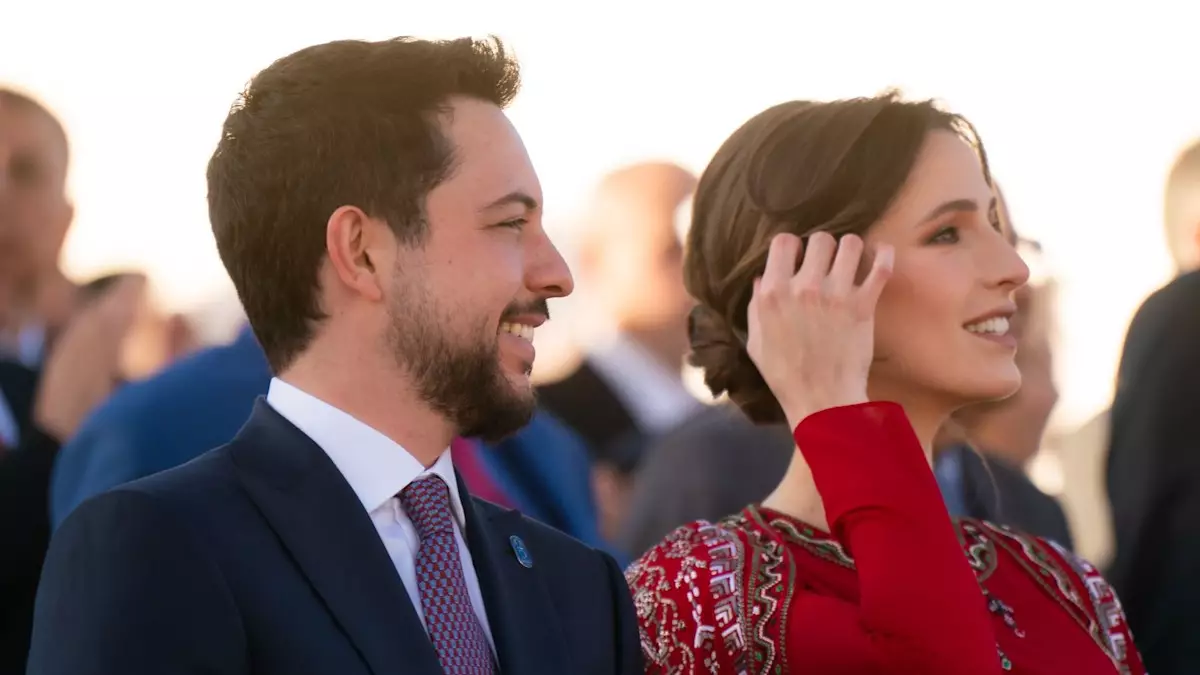The recent high-profile wedding in Venice, uniting internet titan Jeff Bezos and media personality Lauren Sanchez, became a stage for many notable attendees, including Jordan’s Crown Prince Hussein and Princess Rajwa. Though their young daughter, Princess Iman, did not partake in the ceremony itself, her appearances at both arrival and departure moments captured hearts and social media alike. Far from overshadowed by the grandeur of the event, Princess Iman offered a refreshing glimpse of youthful charm through her thoughtfully curated outfits.
Adorned in a charming candy-pink summer set — a Kissy Kissy bodysuit decorated with delicate ruffles — she demonstrated how modest yet stylish children’s fashion can captivate just as much as the dazzling evening wear surrounding her. Her affordable sandals from the brand Next, priced modestly at £11, add an important dimension: accessibility in royal children’s attire is achievable without compromising cuteness or practicality. This element, largely overlooked in celebrity and royal fashion reporting, signals a subtle but welcome shift towards relatable style choices in prestigious settings.
Subtle Royalty Amidst Venetian Glamour
Princess Iman’s brief and discreet presence is a pronounced contrast when placed alongside her parents’ more conspicuous roles throughout the celebration. Princess Rajwa, opting for cozy chocolate brown travel attire upon arrival, demonstrated a deliberate choice to balance comfort with a poised, understated elegance. Yet, when immersed in social gatherings, she embraced the spotlight with an impressive transformation — donning a striking gold jersey maxi dress by Tom Ford, paired with Dolce & Gabbana’s leopard print accessories. This juxtaposition between casual and high glamour fashion speaks volumes about Rajwa’s ability to navigate diverse social environments with both grace and conscious style acumen.
Crown Prince Hussein, while less documented for his sartorial contributions, served as an anchor for the family—both literally, when seen ferrying his daughter across the Venetian waterways and symbolically, through his engagement with the various festivities. The royal couple’s presence synchronized with a personal milestone as well: Hussein’s birthday, adding layers of private joy to this publicly significant event.
Elevating Tradition with Modern Elegance
The wedding itself became a platform for a nuanced display of royal fashion, steeped in cultural respect yet thoroughly modern. Princess Rajwa’s prediction of sartorial headlines was confirmed through her choice of a sheer black gown by designer Hassi Driss. The original ensemble, which featured a full mesh hood, was thoughtfully modified by Rajwa into a more conventional yet still fashion-forward high neckline. This decision reflects an insightful balancing act—honoring traditional royal modesty while fully engaging with contemporary haute couture trends.
Princess Iman’s lovely green chiffon Oscar de la Renta gown further exemplifies this ethos, tailored to accentuate youthful elegance without extravagance. Queen Rania’s appearance, clad in a rainbow Armani Prive gown complemented by a shawl, encapsulated regal maturity blended with approachable warmth. The collective presence of three generations of Jordanian royalty—each elegantly distinct yet harmoniously unified—added a profoundly humanizing and dignified element to the glitzy guest list.
Contextualizing the Royal Participation Among Celebrity Guests
This private wedding drew around 200 high-profile guests, including cultural icons such as Oprah Winfrey, Kim Kardashian, Leonardo DiCaprio, and Ivanka Trump, making it a true nexus of global influence and celebrity glamour. The inclusion of the Jordanian royal family amid such figures raises interesting questions about the evolving role of modern royalty. No longer confined to purely state or ceremonial functions, royals today actively engage in transnational social and philanthropic networks, reinforcing their relevance beyond traditional confines.
The strategic choices in appearance, comportment, and public engagement made by Princess Rajwa and Crown Prince Hussein during this event illustrate a new kind of royal diplomacy — one that is personal, relatable, yet respectful of longstanding traditions. Their navigation of a private yet high-visibility event suggests a conscious effort to maintain mystique and dignity while connecting authentically with diverse audiences.
Fashion and Royal Identity: A Thoughtful Interplay
What stands out most compellingly is how fashion serves as an extension of identity for the Jordanian royals, particularly Princess Rajwa. Her dual approach—comfortable modesty balanced by striking elegance—signals a modernization rooted firmly in respect for her heritage. By contrast, the spotlight-stealing simplicity of Princess Iman’s child-appropriate attire profoundly underscores the idea that even in formidable settings, authenticity and innocence remain paramount.
This balance between public image, cultural responsibility, and individual expression remains a delicate craft for royals navigating today’s hyper-visual world. The Jordanian family’s presence in Venice is a vivid example of this evolving role, one where personal style becomes a powerful language of diplomacy, relatability, and cultural pride—an aspirational model other modern royals might do well to emulate.

